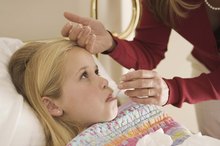Signs Your Child Has Been Infected With Herpes
The herpes simplex virus type 1 (HSV-1) and type 2 (HSV-2) causes oral, genital and congenital herpes infections in children and adults 3. A child can contract herpes from his parents, from other children, or from his infected mother during pregnancy or vaginal birth. There is no cure for herpes, but the frequency and duration of its symptoms can be managed. It is important to recognize the signs that your child has been infected with herpes so that you can get him appropriate treatment and help to prevent the spread of the virus to others.
If you are experiencing serious medical symptoms, seek emergency treatment immediately.
Sores in the Mouth
Children commonly get a condition known as gingivostomatitis which is caused by HSV-1. The main symptom of gingivostomatitis is ulcers in the mouth, and these are often accompanied by fever, pain, irritability and decreased appetite. Some children may refuse to drink fluids because of the painful sores, so dehydration can sometimes be a secondary symptom.
Sores on the Skin
Symptoms of Herpes in Infants
Learn More
Another common sign of herpes are cold sores or fever blisters on the mouth (oral herpes). Sores may also occasionally appear on the face, chin, fingers or nostrils. Oral herpes is easily transmitted from adult to child or child to child by sharing utensils, drinks or towels. The cold sores appear as fluid-filled blisters that are red, painful and tender to the touch. Over the course of a week or two, the blisters break open, ooze, and then dry up and heal.
Herpes gladiatorum is another type of herpes infection that appears on the skin, most commonly around the jaw area. It usually occurs in adolescents who wrestle and who are susceptible to transmission of the herpes virus from tight holds and infected mats.
- Another common sign of herpes are cold sores or fever blisters on the mouth (oral herpes).
- Herpes gladiatorum is another type of herpes infection that appears on the skin, most commonly around the jaw area.
Sores on the Genitals
Genital herpes can be caused by either the HSV-1 or HSV-2 virus, and is identified by herpes blisters in the genital or anal area 3. It is transmitted sexually through genital to genital or oral to genital contact. There may be one blister or a cluster of sores that are filled with a clear or reddish fluid. These blisters soon open up and seep liquid or blood, and eventually crust over and heal. Initial herpes outbreaks are often accompanied by flu-like symptoms such as fever, abdominal pain, headaches or even aseptic meningitis.
- Genital herpes can be caused by either the HSV-1 or HSV-2 virus, and is identified by herpes blisters in the genital or anal area 3.
Signs of Congenital Herpes Simplex
Fever Blisters on a 2-Year-Old
Learn More
Congenital herpes simplex is transmitted from mother to baby in utero or during vaginal delivery. Symptoms usually appear in the first month after the baby is born. Newborns may show signs of irritability, jaundice (yellowing of the skin), trouble breathing, grunting, breathing irregularities, blue appearance, seizures, bleeding and shock. Once infected, some babies may develop localized skin infections in the form of blisters on the face or eyes, while others may develop more serious issues such as encephalitis, an inflammation of the brain that can lead to seizures and damage to the brain and spinal cord. A disseminated herpes infection is one that spreads throughout the body and infects the baby’s vital organs. If left untreated, both encephalitis and disseminated herpes infections can be fatal, so it is critical to seek treatment right away if your baby is showing any of these signs.
- Congenital herpes simplex is transmitted from mother to baby in utero or during vaginal delivery.
- If left untreated, both encephalitis and disseminated herpes infections can be fatal, so it is critical to seek treatment right away if your baby is showing any of these signs.
Related Articles
References
- Mayo Clinic: Genital Herpes
- Opstelten W, Neven AK, Eekhof J. Treatment and prevention of herpes labialis. Can Fam Physician. 2008;54(12):1683–1687.
- Delmonte S, Sidoti F, Ribero S, et al. Recurrent herpes labialis and HSV-1 herpes genitalis: which is the link? G Ital Dermatol Venereol. 2017. doi:10.23736/S0392-0488.17.05563-8
- Glinšek biškup U, Uršič T, Petrovec M. Laboratory diagnosis and epidemiology of herpes simplex 1 and 2 genital infections. Acta Dermatovenerol Alp Pannonica Adriat. 2015;24(2):31-5. doi:10.15570/actaapa.2015.9
- Centers for Disease Control and Prevention. Prevalence of Herpes Simplex Virus Type 1 and Type 2 in Persons Aged 14–49: United States, 2015–2016. Updated February 7, 2018.
- Embil JA, Manuel FR, Mcfarlane ES. Concurrent oral and genital infection with an identical strain of herpes simplex virus type 1. Restriction endonuclease analysis. Sex Transm Dis. 1981;8(2):70-2.
- Stanaway JD, Wald A, Martin ET, Gottlieb SL, Magaret AS. Case-crossover analysis of condom use and herpes simplex virus type 2 acquisition. Sex Transm Dis. 2012;39(5):388–393. doi:10.1097/OLQ.0b013e318248aa8a
- Bonnar PE. Suppressive valacyclovir therapy to reduce genital herpes transmission: good public health policy? Mcgill J Med. 2009;12(1):39–46.
- Cunningham SD, Kerrigan DL, Jennings JM, Ellen JM. Relationships between perceived STD-related stigma, STD-related shame and STD screening among a household sample of adolescents. Perspect Sex Reprod Health. 2009;41(4):225–230. doi:10.1363/4122509
- Embil JA, Manuel FR, McFarlane ES.Concurrent oral and genital infection withan identical strain of herpes simplex virus type 1. Restriction endonucleaseanalysis.Sex Transm Dis. 1981 Apr-Jun;8(2):70-2.
- Glinšek Biškup U, Uršič T, Petrovec M. Laboratory diagnosis and epidemiology of herpes simplex 1 and 2 genital infections. Acta Dermatovenerol Alp Pannonica Adriat. 2015;24(2):31-5
- Lafferty WE, Coombs RW, Benedetti J, Critchlow C, Corey L.Recurrences afteroral and genital herpes simplex virus infection. Influence of site of infectionand viral type. N Engl J Med. 1987 Jun 4;316(23):1444-9.
- Ramchandani M, Kong M, Tronstein E, Selke S, Mikhaylova A, Magaret A, Huang ML, Johnston C, Corey L, Wald A. Herpes Simplex Virus Type 1 Shedding in Tears and Nasal and Oral Mucosa of Healthy Adults. Sex Transm Dis. 2016 Dec;43(12):756-760.
- Ryder N, Jin F, McNulty AM, Grulich AE, Donovan B. Increasing role of herpes simplex virus type 1 in first-episode anogenital herpes in heterosexual women and younger men who have sex with men, 1992-2006. Sex Transm Infect. 2009 Oct;85(6):416-9. doi: 10.1136/sti.2008.033902.
- Delmonte S, Sidoti F, Ribero S, Dal Conte I, Curtoni A, Ciccarese G, Stroppiana E, Stella ML, Costa C, Cavallo R, Rebora A, Drago F. Recurrent herpes labialis and HSV-1 herpes genitalis: which is the link? G Ital Dermatol Venereol. 2017 Feb 8. doi: 10.23736/S0392-0488.17.05563-8.
- Sauerbrei A. Herpes Genitalis: Diagnosis, Treatment and Prevention. Geburtshilfe Frauenheilkd. 2016;76(12):1310-1317. doi:10.1055/s-0042-116494
- Johnston C, Corey L. Current Concepts for Genital Herpes Simplex Virus Infection: Diagnostics and Pathogenesis of Genital Tract Shedding. Clin Microbiol Rev. 2016;29(1):149-61 .doi:10.1128/CMR.00043-15
- Kimberlin DW. Neonatal herpes simplex infection. Clin Microbiol Rev. 2004;17(1):1-13. doi:10.1128/CMR.17.1.1-13.2004
- Cohen BE, Durstenfeld A, Roehm PC. Viral causes of hearing loss: a review for hearing health professionals. Trends Hear. 2014;18. doi:10.1177/2331216514541361
- Morse D, Vangipuram R, Tyring SK. Painful lesions on the arms of a teenage wrestler. Eur J Intern Med. 2018 May 10. doi: 10.1016/j.ejim.2018.05.011.[Epub ahead of print]
- Reynaud C, Rousseau A, Kaswin G, M'garrech M, Barreau E, Labetoulle M. Persistent Impairment of Quality of Life in Patients with Herpes Simplex Keratitis. Ophthalmology. 2017 Feb;124(2):160-169. doi: 10.1016/j.ophtha.2016.10.001. Epub 2016 Nov 15.
Writer Bio
Based in New York City, Tricia Mangan began her writing career in 2001. She has co-authored a National Cancer Institute report and a number of research articles that have appeared in medical journals. Tricia holds a Master of Arts in clinical psychology from Stony Brook University and boasts diverse clinical, research and teaching experience.







